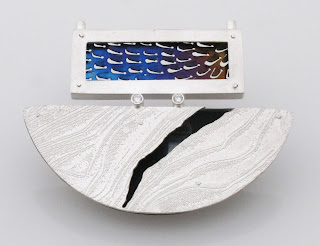Seoyoun Choi is a metal smith from Korea who exhibited works from her first solo show after her MFA exhibition at the JMGA (Jewellers and Metalsmith's Group of Australia) conference in January this year. Held at the Nexus Multicultural Arts Centre, Choi’s work undoubtedly raises questions regarding the conventions of jewellery practice. While she creates brooches with geometric and figurative aesthetics, her body jewellery can perhaps be described in terms of interactive or performative tools between artist and ‘user’, rather than artist and ‘wearer’. Refreshingly atypical from conventional jewellery practice, these works still rely on the body as ‘site’ or ‘context’, but in terms of interaction, movement, and engagement rather than in terms of aesthetic, ornamental, and static value. In doing so, her craft does not serve as an accessory, but as an ‘amusement form’ that explores rhythm, joy, light and simultaneously focuses on the importance of undeniable human desires to pursue pleasure.
In reviewing her works I am reminded of this question:
“Did the composition or the concept make it jewellery? Which was the focus – the adornment of the body, or the body as adorned?”
(Patricia Harris & David Lyon)
















